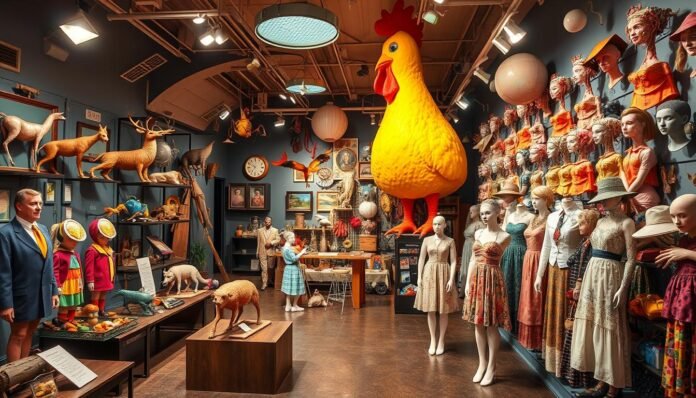Did you know there are over 55,000 museums worldwide? Many show traditional art, history, and science. But some museums dive into the weird and unusual. They offer a peek into the odd side of human culture and history.
These museums celebrate the worst in art and the morbid fascination with medical oddities. They challenge our views of what a museum should be. Let’s take a virtual tour of the top 10 weirdest museums globally. We’ll look at their standout exhibits and the stories behind them.
Get ready to be amazed, disgusted, and captivated. These museums show the eccentric side of human nature.
Key Takeaways
- Discover the world’s quirkiest museums that showcase bizarre exhibits and eccentric displays
- Explore offbeat tourism destinations that offer unconventional experiences for adventurous travelers
- Learn about the fascinating stories behind the creation of these strange museums and their curators
- Challenge your perceptions of what a museum should be and embrace the weird and wonderful
- Embark on a virtual tour of the top 10 weirdest museums, from the Museum of Bad Art to the Icelandic Phallological Museum
Embrace the Bizarre: Unveiling the World’s Quirkiest Museums
In a world where everyone tries to be the same, there’s a place for the odd and the unusual. Welcome to quirky museums, where offbeat tourism is alive and well. Here, visitors get to see the most peculiar parts of human creativity.

These museums are not your usual places for art or history. They celebrate the strange and the curious. They show us the world through the eyes of those who see things differently.
Visiting these museums is a chance to see things in a new way. They show us that the world is full of mysteries and wonders. By exploring these places, we learn to appreciate the diversity of human experience.
In the next parts, we’ll explore some of the world’s weirdest museums. You’ll see a temple for bad art and a place that loves medical oddities. Get ready for a journey into the strange and wonderful world of quirky museums.
The Museum of Bad Art: Celebrating the Best of the Worst
In Massachusetts, the Museum of Bad Art (MOBA) is a unique spot. It’s filled with art that’s so bad, it’s good. When you walk in, you’ll see art that challenges what we think of as good art. It shows the beauty in things that aren’t perfect.
The Origins of MOBA: From Trash to Treasure
The Museum of Bad Art started with a surprising find in 1993. Scott Wilson, an antique dealer, found a painting in a trash heap. This discovery led to the idea of a museum for bad art. Now, MOBA is known for its unique art collection.

Exploring the Collection: Masterpieces of Mediocrity
At MOBA, you’ll see art that’s different from what you’re used to. There are funny portraits and strange landscapes. Each piece has its own story of artistic failure.
Some of the standout pieces include:
- “Lucy in the Field with Flowers” – A strange portrait with odd features and a creepy look.
- “Eileen” – A dreamlike scene that messes with your sense of space and time, making you laugh and wonder.
- “Sunday on the Pot with George” – A weird still life that mixes everyday things in a way that makes you think.
MOBA picks art based on how bad it is. It looks for art that lacks skill, has a weird vision, or is funny by accident. The curators choose carefully to make sure only the best bad art is shown.
| Artwork | Artist | Year | Medium |
|---|---|---|---|
| Lucy in the Field with Flowers | Unknown | c. 1970s | Oil on canvas |
| Eileen | R. Angelo Le | 1954 | Oil on board |
| Sunday on the Pot with George | Unknown | c. 1990s | Mixed media |
MOBA is a place like no other. It celebrates the weird and the bad in art. It’s a place where you can see the beauty in mistakes. Whether you love art or just want something different, MOBA is a journey you won’t forget.
The Mütter Museum: A Morbid Fascination with Medical Oddities
In the heart of Philadelphia, the Mütter Museum is a unusual attraction for the curious and brave. It’s part of The College of Physicians of Philadelphia. Here, you’ll find a vast collection of medical oddities, specimens, and strange artifacts that reveal medical history’s fascinating side.

Upon entering, visitors are met with eccentric displays that highlight the human body’s beauty and complexity. They also show the creativity and sometimes wrong turns of medical history. The museum’s collection includes preserved organs, skeletal oddities, and antique tools, all showing the human spirit’s strength and the drive for medical knowledge.
The Legacy of Dr. Thomas Mütter: A Pioneer in Medical Education
The Mütter Museum was founded by Dr. Thomas Dent Mütter, a pioneer in plastic surgery. He believed in hands-on learning and preserving specimens for future students. In 1858, he gave over 1,700 items to The College of Physicians of Philadelphia, starting the museum.
Dr. Mütter’s work went beyond the museum. At Jefferson Medical College, he introduced new teaching methods like live surgeries and wax models. These helped his students understand anatomy and surgery better. His commitment to education and patient care still guides the museum today.
Highlights of the Collection: From Skulls to Specimens
The Mütter Museum’s collection is a vast array of medical oddities, with over 25,000 items spanning centuries. Some highlights include:
- The Hyrtl Skull Collection: 139 skulls from different ethnicities, proving phrenology wrong.
- The Soap Lady: A woman whose body turned into soap due to a rare preservation process.
- The Megacolon: A giant colon from a man with Hirschsprung’s disease, over 5 feet long.
- The Chevalier Jackson Collection: Over 2,000 objects swallowed by Dr. Jackson’s patients.
These strange artifacts and specimens are both captivating and educational. They show the human body’s complexity and the growth of medical knowledge. Visitors leave with a deeper respect for the human body and the medical professionals who study it.
The Icelandic Phallological Museum: A Unique Tribute to Male Genitalia
In Reykjavík, Iceland, you’ll find a museum like no other. The Icelandic Phallological Museum is a bizarre exhibit and unusual attraction. It’s dedicated to penises and penile parts from many animals. It’s a curious destination for those who love the unusual.
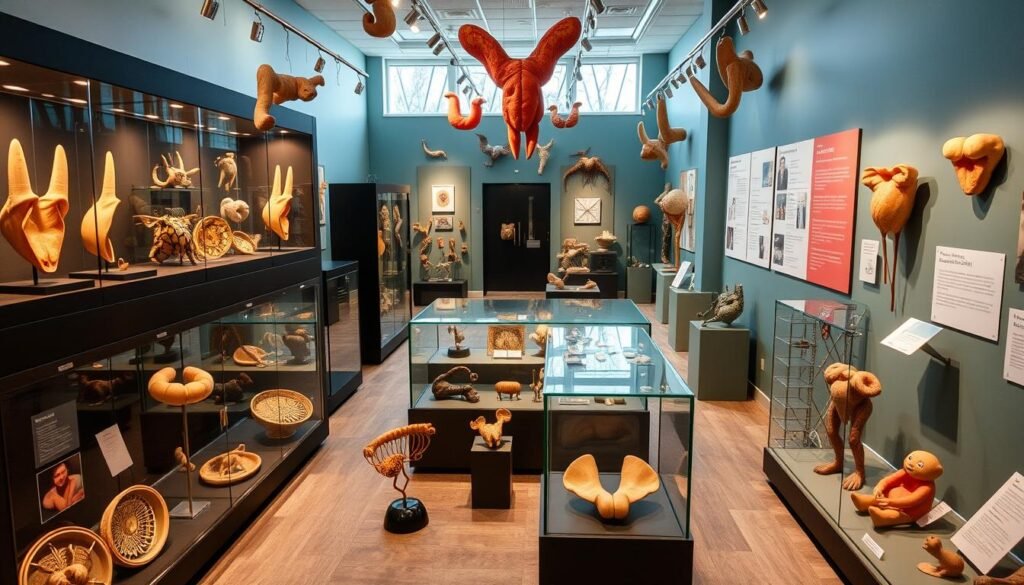
Sigurður Hjartarson, a former teacher, started this museum. He’s fascinated by phallology. The museum has over 280 specimens from more than 90 species. You’ll see everything from hamster to whale penises.
Here, you can see penises from mammals like whales, seals, and polar bears. Even humans are part of the collection. It’s a chance to see the amazing variety of male reproductive organs in nature.
- Whales
- Seals
- Polar bears
- Walruses
- Reindeer
- And even humans
The museum’s star is the 5.58 ft long blue whale penis. It’s the largest penis in the animal kingdom. But there’s more than just biological specimens. You’ll also see penis-themed art and cultural artifacts from around the world.
Sigurður Hjartarson wants to educate people about male reproductive organs. He hopes to make this topic less taboo. The museum aims to spark interesting conversations and understanding.
| Species | Number of Specimens |
|---|---|
| Whales | 17 |
| Seals and Walruses | 22 |
| Land Mammals | 115 |
| Humans | 4 |
The museum is a hit with tourists. People come from all over to see this unique collection. It’s a place where science meets curiosity, leaving a lasting impression on all who visit.
The Museum of Everyday Life: Finding Wonder in the Mundane
In Vermont, USA, the Museum of Everyday Life shines a light on the ordinary. It celebrates the beauty in everyday objects we often overlook. Visitors find wonder and meaning in the small things through its unique exhibits and experiences.
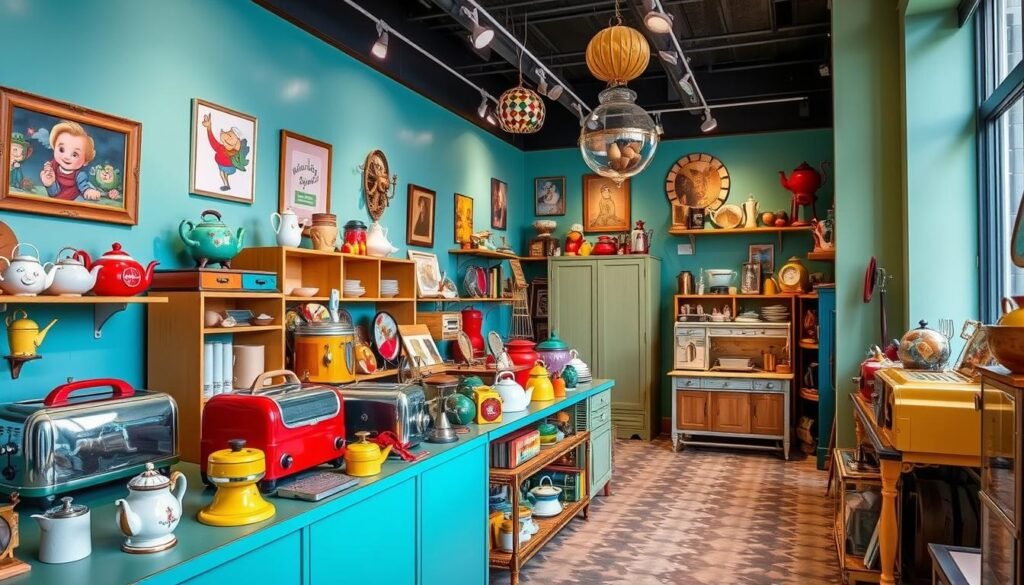
The Philosophy Behind the Museum: Celebrating the Ordinary
The Museum of Everyday Life believes every object has a story. It turns the ordinary into art, making us rethink what’s valuable. It invites us to see magic in the everyday and value the overlooked.
Notable Exhibits: From Toothbrushes to Pencil Stubs
The Museum showcases quirky collections that reflect human diversity. Some standout exhibits include:
- The Toothbrush Collection: A display of toothbrushes from various eras and cultures, showing oral hygiene’s evolution.
- The Pencil Stub Gallery: Celebrating creativity, it features worn-out pencil stubs with their own stories of inspiration.
- The Lost Glove Project: It reminds us of the brief nature of human connections, with lost gloves telling untold stories.
These exhibits encourage visitors to see the world anew, finding beauty in unexpected places.
| Exhibit | Description | Significance |
|---|---|---|
| The Toothbrush Collection | A display of toothbrushes from different eras and cultures | Highlights the evolution of oral hygiene and the role of this humble tool in our daily lives |
| The Pencil Stub Gallery | A collection of well-worn pencil stubs | An ode to the creative process and the stories of inspiration and creation |
| The Lost Glove Project | A collection of lost gloves | A poignant reminder of the fleeting nature of human connection and untold stories |
The Museum of Broken Relationships: A Cathartic Journey Through Heartbreak
In Zagreb, Croatia, you’ll find a special place called the Museum of Broken Relationships. It’s a place where love, loss, and the human spirit shine. Here, you can see objects and stories from broken relationships worldwide. It’s a chance to think about your own heartbreak and find comfort in knowing you’re not alone.

When you enter, you’ll see strange artifacts with stories of broken love. You might see a wedding dress in a jar or a pair of handcuffs. These objects take on a new meaning when you see them through the eyes of someone who’s been hurt.
The museum helps people heal by sharing their stories. By donating items and telling their stories, people find closure. Visitors can connect with these stories, creating a sense of community and understanding.
The museum keeps growing with new donations from everywhere. Each piece tells a different story of how love can end. You might laugh or cry as you see the unconventional experiences of others. It’s a chance to see that you’re not the only one who’s felt this way.
- A teddy bear with a missing eye, symbolizing the pain of a long-distance relationship
- A love letter, never sent, expressing the words left unsaid
- A single high-heeled shoe, representing the day a partner walked out the door
The Museum of Broken Relationships is more than just a collection. It shows how strong the human heart can be. By sharing our heartbreak, we find strength in knowing we’re not alone. This unusual attraction offers a unique look at love and loss, reminding us of hope for healing and new starts.
Leila’s Hair Museum: A Hairy Tale of Victorian Sentiment
In Missouri, USA, Leila’s Hair Museum is a special place. It shows the art of hairwork from the Victorian era. This craft was once loved by many. Now, it’s a chance for visitors to see the beauty and emotion in these hair pieces.
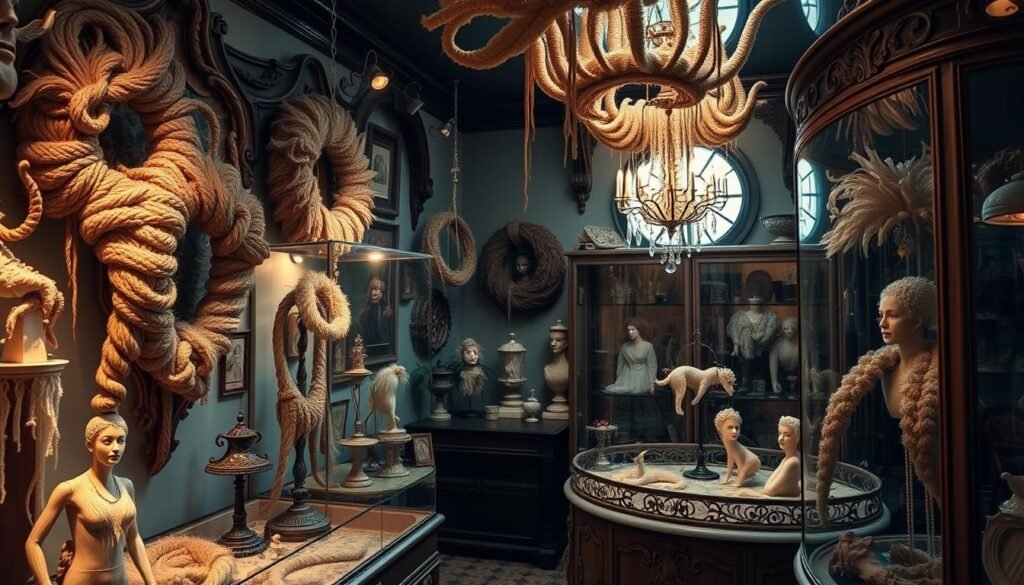
The Art of Hairwork: A Forgotten Craft
Hairwork was a way to remember loved ones in the Victorian era. It involved making jewelry and art from human hair. This craft needed skill and patience, with hair being woven and braided into designs.
Some common hairwork pieces include:
- Mourning jewelry, such as brooches and lockets
- Hair wreaths and paintings
- Watch chains and fobs
- Friendship bracelets and rings
The Leila Cohoon Collection: A Lifetime Dedicated to Hair
Leila Cohoon started Leila’s Hair Museum. She found a hair wreath at an antique shop and was fascinated. This sparked her journey to collect and preserve hairwork.
Her collection has over 2,000 hair pieces, including:
| Type of Hairwork | Number of Pieces | Noteworthy Examples |
|---|---|---|
| Hair Wreaths | 50+ | The Sutherland-Macculloch Wreath, featuring hair from 4 generations |
| Jewelry | 1,000+ | Intricate brooches, lockets, and watch chains |
| Paintings and Sculptures | 25+ | A hair painting depicting the Biblical story of Samson and Delilah |
| Postcards and Memorabilia | 500+ | Victorian-era postcards adorned with hair and sentimental messages |
Leila’s Hair Museum is a unique place to see hairwork. It shows the love and loss of the Victorian era. It still fascinates and inspires people from all over.
Top 10 Weirdest Museums You Should Visit
Start an amazing journey through weird museums. You’ll see quirky collections and bizarre exhibits. These places will make you see museums in a new way. Get ready for offbeat tourism and unusual attractions.
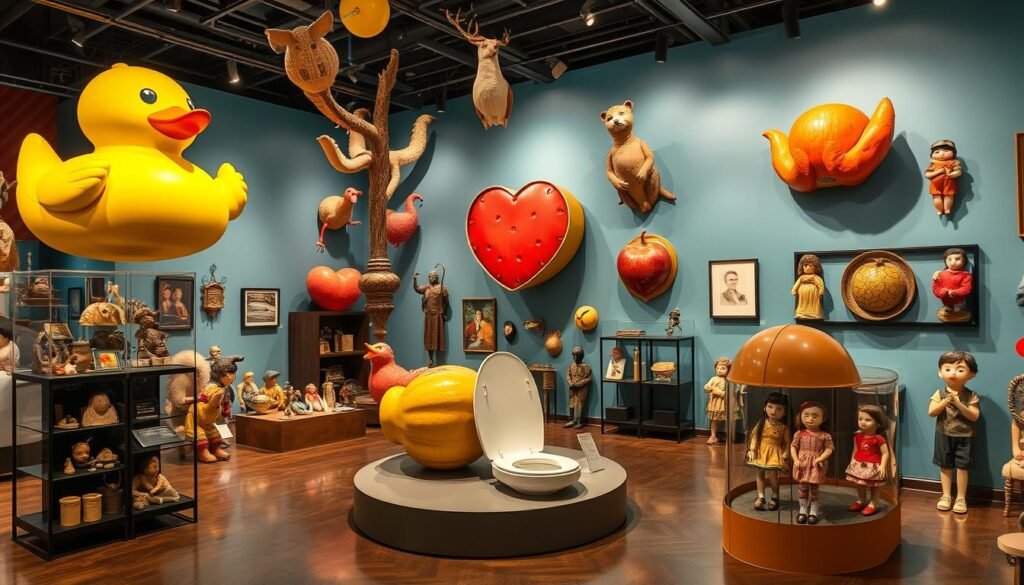
The Mütter Museum, Philadelphia, USA
Enter the world of medical oddities at The Mütter Museum in Philadelphia. It has an odd collection of specimens and ancient tools. You’ll see everything from the “Soap Lady” to the biggest colon on display.
The Museum of Bad Art, Massachusetts, USA
Laugh at the worst art at The Museum of Bad Art (MOBA) in Massachusetts. It’s all about art that’s not quite right. You’ll see weird portraits and landscapes that make you question art itself.
The Icelandic Phallological Museum, Reykjavík, Iceland
Explore male genitalia at The Icelandic Phallological Museum in Reykjavík. It has over 200 phallic specimens from animals and humans. It’s a unique look at the animal kingdom and human culture.
The Museum of Everyday Life, Vermont, USA
See the beauty in everyday things at The Museum of Everyday Life in Vermont. It celebrates simple objects like toothbrushes and pencil stubs. It makes you think about the stories behind these items.
The Museum of Broken Relationships, Zagreb, Croatia
Feel the pain of lost love at The Museum of Broken Relationships in Zagreb. It shows artifacts and stories from failed relationships. Each piece tells a story of love and loss.
Leila’s Hair Museum, Missouri, USA
Go back in time at Leila’s Hair Museum in Missouri. It has Victorian-era hair art like jewelry and wreaths. It’s a fascinating look at a forgotten craft.
The Sulabh International Museum of Toilets, Delhi, India
Learn about toilets and waste management at The Sulabh International Museum of Toilets in Delhi. It shows how toilets have changed over time. It’s a unique look at something we often overlook.
The Torture Museum, Amsterdam, Netherlands
See the dark side of history at The Torture Museum in Amsterdam. It has torture devices from different times. It’s a chilling reminder of human cruelty.
The Momofuku Ando Instant Ramen Museum, Osaka, Japan
Enjoy instant noodles at The Momofuku Ando Instant Ramen Museum in Osaka. It’s all about the inventor of instant ramen. You can make your own noodles and see cool exhibits.
The International Cryptozoology Museum, Maine, USA
Search for mythical creatures at The International Cryptozoology Museum in Maine. It’s all about hidden animals like Bigfoot and the Loch Ness Monster. It’s a place for mystery and discovery.
| Museum | Location | Highlight |
|---|---|---|
| The Mütter Museum | Philadelphia, USA | Medical oddities and anatomical specimens |
| The Museum of Bad Art | Massachusetts, USA | Celebrating art that falls short of conventional standards |
| The Icelandic Phallological Museum | Reykjavík, Iceland | Extensive collection of phallic specimens from various species |
| The Museum of Everyday Life | Vermont, USA | Finding wonder in mundane objects |
| The Museum of Broken Relationships | Zagreb, Croatia | Personal artifacts and stories from failed relationships |
| Leila’s Hair Museum | Missouri, USA | Victorian-era hair art and intricate creations |
| The Sulabh International Museum of Toilets | Delhi, India | Evolution of toilets and waste management systems |
| The Torture Museum | Amsterdam, Netherlands | Torture devices and instruments used throughout history |
| The Momofuku Ando Instant Ramen Museum | Osaka, Japan | Interactive experience celebrating instant noodles |
| The International Cryptozoology Museum | Maine, USA | Mythical creatures and legendary beasts |
Conclusion
Exploring the top 10 weirdest museums shows us that the unusual can be just as enriching as the familiar. These places offer a fresh look at art, science, and history. They challenge our views and open our minds to new ideas.
Why not add these quirky museums to your travel list? You might enjoy the medical oddities at the Mütter Museum or the unique artwork at MOBA. The Icelandic Phallological Museum’s collection of male genitalia is also a must-see. Each visit is a chance to learn and laugh, thanks to the creativity of these museums.
These museums remind us that the world is full of surprises. By seeking out the unusual, we can make our lives more interesting. So, take a chance and explore these museums. You’ll find experiences that are truly unique and unforgettable.


